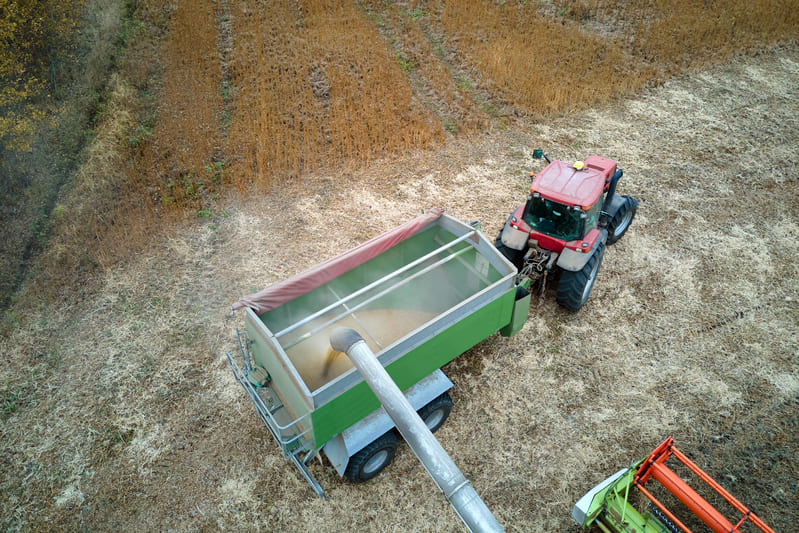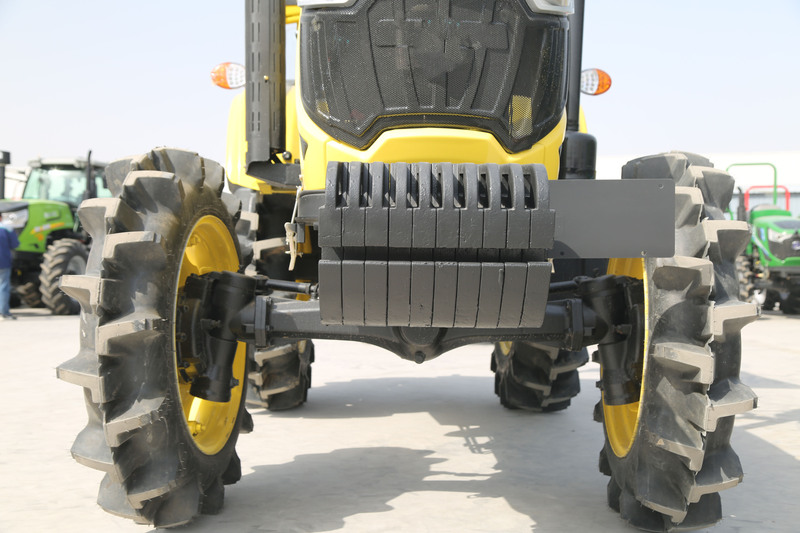I remember the day when our farm faced its biggest challenge. The rain wouldn’t stop, turning the fields into a slippery, muddy mess. Our old 2WD tractor struggled to make it through, spinning its wheels helplessly as the clock ticked away. That’s when I realized we needed something more capable.
4WD tractors1 offer a host of advantages, including superior traction2, enhanced power3, greater versatility, increased safety, reduced tire wear, improved maneuverability, durability with better resale value, and adaptability to modern technology. These features make them ideal for handling tough terrains, heavy workloads, and diverse farming applications efficiently and reliably.
You may often face a choice when purchasing tractors: 2WD or 4WD? To help you make an informed decision, let’s dive into the key advantages of 4WD tractors.
4WD tractors provide superior traction, enhanced power, and greater versatility, making them ideal for tough terrains and heavy workloads.True
With power distributed to all four wheels, 4WD tractors handle slippery, muddy conditions, heavy implements, and diverse farming tasks more efficiently than 2WD models.
2WD tractors are just as capable as 4WD tractors in handling tough terrains and heavy workloads.False
2WD tractors often struggle in muddy or uneven conditions due to limited traction, making them less reliable for challenging farming applications compared to 4WD models.
1. Superior Traction in Varied Conditions
You know the frustration of losing time and productivity because of challenging terrains4. Muddy fields, sandy soil, and steep inclines can make farming operations nearly impossible with standard equipment.
4WD tractors excel in providing consistent traction5 across varied terrains, including wet, muddy fields, sandy soils, snow, and steep inclines. By evenly distributing power to all four wheels, they minimize slippage and maintain stability. This makes them an essential choice for farmers working in challenging environments.

How do 4WD tractors ensure increased grip6?
Loose or uneven soil can spell trouble for standard tractors, especially during critical tasks like seedbed preparation after rain. With 4WD, the grip on challenging surfaces is significantly improved.
For instance, clay-heavy fields that turn slippery after a rainfall are no longer a concern. The 4WD system allows the tractor to maintain traction, avoiding delays and inefficiencies. This consistent grip ensures every task is completed on schedule, regardless of the ground conditions.
Why are hills and slopes easier to navigate with 4WD?
Hilly farmland presents a unique set of challenges. A 4WD tractor excels by having the rear and front axles work together to distribute power. This collaboration reduces wheelspin7, even when pulling heavy equipment uphill.
For example, imagine plowing a steep incline while hauling a trailer. A 4WD tractor keeps its footing steady, providing stability8 and allowing the operator to focus on productivity rather than constantly compensating for slipping tires.
How does 4WD reduce soil compaction9?
Soil health is critical for long-term productivity, and 4WD tractors excel in protecting it. Unlike 2WD models that concentrate weight on the rear tires, 4WD systems distribute the workload across all four wheels. This reduces the pressure exerted on the soil.
Moreover, by using wider tires or dual configurations, the pressure per square inch is further decreased. This feature makes 4WD tractors a better option for farmers aiming to preserve their soil’s structure and fertility, ensuring sustainable yields for years to come.
| Feature | 4WD Advantage | Outcome |
|---|---|---|
| Increased Grip | Enhanced traction on loose/uneven soil | Reduced delays, improved efficiency |
| Hills and Slopes | Better power distribution across axles | Stability and prevention of wheelspin |
| Reduction in Soil Compaction | Weight distributed across four wheels | Healthier soil with less compaction |
4WD tractors are not just a luxury—they are a necessity for you tackling unpredictable and varied terrains. Their superior traction makes every farming task smoother and more efficient.
4WD tractors provide increased grip on loose or uneven soil, ensuring consistent traction during challenging tasks.True
By distributing power to all four wheels, 4WD tractors maintain traction in slippery or clay-heavy fields, preventing delays and inefficiencies.
Hills and slopes are just as easy to navigate with 2WD tractors as with 4WD models.False
2WD tractors struggle on inclines due to limited traction, while 4WD systems distribute power to reduce wheel spin and ensure stability, even when pulling heavy equipment.
2. Enhanced Power and Efficiency
There was a time when I struggled to get the most out of my tractor. Operating heavy implements like subsoilers or plows felt like an uphill battle, especially on loose or uneven soil. Despite pushing the engine to its limit, so much energy seemed to go to waste. That’s when I switched to a 4WD tractor, and the difference was remarkable.
4WD tractors optimize engine power by distributing it evenly to all four wheels. This improves traction, reduces wheelspin, and maximizes efficiency when operating heavy implements. Additionally, 4WD systems minimize fuel consumption10 by reducing energy loss, making them more cost-effective for demanding tasks like plowing, hauling, or spreading slurry.

How do 4WD tractors improve power delivery11?
The core advantage of a 4WD system lies in its ability to channel more engine power into actual work. With all four wheels gripping the ground, less energy is lost to slippage.
For instance, when pulling a heavy implement like a subsoiler or large seed drill, you’ll notice that the 4WD tractor doesn’t just spin its wheels trying to get traction. Instead, it moves forward smoothly, putting the engine’s horsepower to full use. This means higher productivity and less wear on the machine.
Why are 4WD tractors more fuel-efficient?
Efficiency isn’t just about power—it’s also about conserving resources. A 4WD tractor minimizes energy loss12 through its superior traction, which means you burn less fuel to complete the same tasks compared to a 2WD model.
Take spreading slurry or pulling a forage wagon as an example. These tasks often require consistent performance over long hours. With 4WD, there’s no need to compensate for slippage or backtrack over unfinished work. The result? You save fuel with every task, and those savings compound over time, lowering overall operational costs13.
Dive Deeper
| Feature | 4WD Advantage | Outcome |
|---|---|---|
| Improved Power Delivery | Reduced slippage, better traction | More engine power translates into forward motion |
| Fuel Efficiency | Less energy wasted due to wheelspin | Lower fuel consumption, reduced operational costs |
| Heavy-Duty Applications | Better suited for pulling and plowing tasks | Faster task completion with less stress on the machine |
Switching to 4WD tractors isn’t just about improving productivity; it’s about making every drop of fuel and ounce of power count.
4WD tractors improve power delivery by reducing wheel slippage and maximizing engine efficiency.True
With power distributed to all four wheels, 4WD tractors maintain traction, channeling more horsepower into productive work and reducing energy loss.
4WD tractors consume more fuel than 2WD models for the same tasks.False
4WD tractors are more fuel-efficient because their improved traction minimizes slippage and energy loss, reducing fuel consumption during tasks like pulling heavy implements.
3. Greater Versatility Across Tasks
I remember how challenging it used to be when one machine couldn’t handle everything I needed. Switching between equipment, dealing with downtime, or struggling through specific tasks was frustrating. That’s where 4WD tractors made a difference—they’re truly built to handle a wide variety of work, no matter the conditions or time of year.
4WD tractors adapt seamlessly to multiple roles, excelling in fieldwork, transport, heavy-duty applications14, and year-round tasks. Their stability, power, and reliability make them indispensable for diverse operations15.

How do 4WD tractors excel in both field and transport work?
From plowing and planting to hauling heavy grain trailers on rough tracks, 4WD tractors ensure smoother operations. Their additional traction and stability16 make it easy to transition between field tasks and transport duties without worrying about getting stuck or wasting time.
For example, when transporting harvested crops on uneven terrain, the enhanced grip17 of 4WD prevents unnecessary delays. This means you spend less time managing breakdowns or struggling with unstable loads, keeping your workflow on track.
Why are 4WD tractors ideal for heavy-duty applications?
When it comes to pulling large planters18 or operating front-end loaders with heavy attachments, 4WD tractors stand out. Their power and stability provide a smoother experience and reduce the risk of accidents or equipment strain.
For instance, handling a large planter during planting season can be daunting, but with 4WD, the process is far more efficient. You’ll notice less wheelspin, better control, and a reduction in stress on both the tractor and the implement.
Can 4WD tractors be used year-round?
One of the most underrated benefits of 4WD tractors is their ability to perform across all seasons. Whether you’re preparing the soil in spring, cultivating in summer, harvesting in fall, or clearing snow in winter, 4WD tractors deliver consistent performance19.
Their traction and power ensure that even in winter’s icy or snowy conditions, tasks like snow removal20 or hauling are manageable. This makes them a true year-round investment for any operation.
Dive Deeper: Versatility and Year-Round Usage
| Task Type | 4WD Advantage | Outcome |
|---|---|---|
| Field and Transport Work | Enhanced traction and stability | Smooth transitions, reduced downtime |
| Heavy-Duty Applications | Increased power and control | Safer, more efficient handling of large implements |
| Year-Round Utility | Reliable performance in all weather | Consistent productivity across all four seasons |
With a 4WD tractor, you’re not just buying a machine—you’re gaining a reliable partner for every task, every season, and every challenge. That versatility is what sets them apart.
4WD tractors excel in both field and transport work due to their enhanced traction and stability.True
The additional grip provided by 4WD ensures smooth operation on uneven terrain, reducing delays and improving efficiency in field and transport tasks.
4WD tractors are unsuitable for heavy-duty applications like pulling large implements or operating loaders.False
4WD tractors are specifically designed for heavy-duty tasks, offering better control, reduced wheelspin, and increased stability during demanding operations.
4. Increased Safety and Stability
I’ll never forget the unease I felt when working on uneven terrain with a fully loaded trailer. Every turn felt risky, and I was always cautious about tipping over or losing control. Switching to a 4WD tractor brought me peace of mind. With its improved stability and braking, I could focus on the job without worrying about accidents.
4WD tractors provide enhanced safety through better weight distribution, improved braking systems21, and reduced risk of rollovers22. These features make them dependable for challenging conditions and heavy workloads.

How do 4WD tractors reduce the risk of rollovers23?
Uneven ground and slopes are often unavoidable. With a 4WD system, power and weight are distributed across all four wheels, giving you better balance and stability. This makes tipping or rolling far less likely, even when carrying heavy loads or navigating tight turns.
For instance, when transporting a full load of grain on a sloped path, a 2WD tractor might feel unsteady. A 4WD tractor, however, provides a secure footing, allowing you to maneuver confidently and safely.
What makes braking more effective in 4WD tractors?
Many 4WD tractors come equipped with braking systems that engage all four wheels. This significantly improves stopping power24, especially on slick or loose surfaces where traditional 2WD brakes might fail to grip effectively.
Imagine working on a muddy field or descending a slope after rainfall. A 2WD tractor’s rear brakes might struggle to stop the machine, increasing the risk of skidding. In contrast, a 4WD tractor’s four-wheel braking system25 ensures shorter stopping distances and greater control.
Dive Deeper: Safety and Stability Features
| Feature | 4WD Advantage | Outcome |
|---|---|---|
| Reduced Risk of Rollovers | Even weight and power distribution | Greater stability, especially on slopes |
| Enhanced Braking | Braking system engages all four wheels | Shorter stopping distances, improved control |
| Maneuverability in Tight Spaces | Improved traction and balance | Safer turns with heavy loads |
Safety is non-negotiable, and with a 4WD tractor, you gain the confidence to take on difficult tasks without putting yourself or your equipment at risk. Better stability and braking translate into fewer accidents and smoother operations.
4WD tractors reduce the risk of rollovers by providing better balance and stability on uneven ground and slopes.True
With power and weight distributed across all four wheels, 4WD tractors maintain a secure footing, even when carrying heavy loads or navigating sloped terrain.
Braking in 4WD tractors is no more effective than in 2WD models.False
4WD tractors often feature four-wheel braking systems, which improve stopping power and control, especially on slick or loose surfaces.
5. Reduced Tire Wear and Maintenance Costs
I used to dread the frequent tire replacements and repair bills that came with my old 2WD tractor. The rear tires bore most of the load, and components wore out faster than I expected. Switching to a 4WD tractor not only improved performance but also significantly reduced these recurring costs.
4WD tractors reduce tire wear by distributing the workload evenly across all four wheels, minimizing strain on the rear tires. Additionally, the improved efficiency of 4WD systems decreases stress on components like the drivetrain and axles, leading to fewer repairs and lower long-term maintenance costs.

Why do 4WD tractors reduce strain on rear tires?
In a 2WD tractor, the rear tires26 do most of the heavy lifting, which accelerates their wear and tear. 4WD tractors, on the other hand, share the workload between the front and rear tires, reducing the burden on any single set.
For example, when hauling a heavy grain trailer27 over long distances, a 4WD tractor ensures that all four tires contribute equally to the effort. This not only prolongs the lifespan of the rear tires but also reduces replacement costs over time.
How does 4WD lead to lower maintenance frequency?
Efficiency isn’t just about power or speed—it’s also about reducing strain on vital components. With 4WD, the system minimizes wheelspin and distributes power evenly, which results in less wear on the drivetrain28 and axles.
For instance, heavy-duty tasks like plowing or pulling large equipment in challenging terrain often push a 2WD tractor’s drivetrain to its limits. A 4WD tractor, however, handles the same workload with reduced stress on its components, leading to fewer breakdowns and longer intervals between repairs.
Dive Deeper: Cost-Saving Features of 4WD
| Feature | 4WD Advantage | Outcome |
|---|---|---|
| Less Strain on Rear Tires | Workload is evenly distributed | Extended tire lifespan, reduced replacement costs |
| Lower Maintenance Frequency | Reduced stress on drivetrain and axles | Fewer repairs, lower long-term costs |
| Efficiency in Heavy Work | Minimizes wheelspin and energy loss | Less wear on key components |
While a 4WD tractor may have a higher initial price, the long-term savings in tire replacements, maintenance, and repairs make it a cost-effective investment.
4WD tractors reduce strain on rear tires by distributing workload evenly between all four tires.True
By sharing the effort across front and rear tires, 4WD tractors prevent excessive wear on the rear tires, extending their lifespan and lowering replacement costs.
4WD tractors increase the frequency of drivetrain maintenance due to added complexity.False
4WD tractors reduce wheelspin and distribute power evenly, resulting in less strain on the drivetrain and fewer maintenance needs compared to 2WD models.
6. Improved Maneuverability
When I first considered switching to a 4WD tractor, I worried it might be harder to handle in tight spaces. To my surprise, I found it was even more maneuverable than my old 2WD model, thanks to modern advancements like articulated designs and front-wheel assist29. It quickly became an invaluable part of my operation.
4WD tractors have evolved to offer exceptional maneuverability, with features like articulated steering30 and compact designs. Front-wheel assist adds further flexibility, making these tractors adaptable to various tasks and spaces.

How do articulated and compact 4WD tractors improve maneuverability?
Advances in 4WD tractor design have resulted in models that excel in tight spaces. Articulated 4WD tractors, for instance, use pivoting frames to achieve sharper turning radii, making them ideal for navigating headlands or tight corners in fields.
Similarly, compact 4WD tractors31 are becoming a popular choice for operations like orchards or vineyards, where precision and agility are essential. Their smaller size and improved handling ensure you can move between rows or around obstacles without compromising power or efficiency.
What role does front-wheel assist (FWA) play in maneuverability?
Front-wheel assist, or FWA, is a feature available in many modern 4WD tractors. This system allows you to switch between 4WD and 2WD modes32 modes depending on the task at hand. For tasks that require maximum traction, you can engage 4WD. When maneuverability or fuel savings are a priority, you can easily switch to 2WD.
For example, when performing headland turns33 during fieldwork, switching to 2WD can make the process smoother and quicker, while still allowing you to re-engage 4WD when extra traction is needed for tougher conditions.
Dive Deeper: Maneuverability Features of 4WD Tractors
| Feature | 4WD Advantage | Outcome |
|---|---|---|
| Articulated Models | Pivoting frames for tighter turning radii | Easier navigation in tight spaces |
| Compact 4WD Models | Smaller designs with enhanced handling | Perfect for orchards, vineyards, and confined areas |
| Front-Wheel Assist (FWA) | Switchable 4WD/2WD modes | Optimized traction, agility, and fuel efficiency |
Modern 4WD tractors are a testament to how far agricultural equipment has come. They’re no longer just powerful—they’re also agile and adaptable, proving their value in a wide range of applications and environments.
Articulated and compact 4WD tractors improve maneuverability by offering sharper turning radii and precision handling.True
Articulated tractors use pivoting frames for tight turns, while compact 4WD models excel in confined spaces like orchards or vineyards, ensuring agility without sacrificing power.
Front-wheel assist (FWA) in 4WD tractors has no impact on maneuverability or traction.False
FWA allows operators to switch between 4WD and 2WD modes, improving traction for challenging tasks and enhancing maneuverability for tight turns or lighter work.
7. Longevity and Resale Value
When I invested in my 4WD tractor, I wasn’t just thinking about its immediate benefits—I also considered how it would hold up over time. Years later, it’s still going strong, and I know its resale value34 will be much higher than comparable 2WD models. That long-term reliability35 is worth every penny.
4WD tractors are built to withstand heavy workloads and challenging conditions, making them last longer. Their durability and versatility ensure strong demand in the resale market, maximizing their value over time.

Why do 4WD tractors last longer?
4WD tractors are designed with durability36 in mind. Their components, such as the axles, drivetrain, and chassis, are built to handle higher stress loads and challenging terrains. This rugged construction37 ensures they remain reliable, even under heavy use.
For example, a 4WD tractor used for frequent plowing or hauling heavy trailers will typically last longer than a 2WD model of the same size. The 4WD system spreads the workload evenly, reducing strain on individual parts and prolonging the machine’s lifespan.
What makes the resale value of 4WD tractors higher?
The resale market for 4WD tractors is consistently strong because buyers understand their value. Their all-weather, all-terrain capabilities38 and reputation for durability make them a sought-after choice for secondhand buyers.
When it’s time to upgrade, selling a used 4WD tractor is often easier and more profitable. Potential buyers are willing to pay a premium for the reliability and versatility these tractors offer. This makes upgrading to newer models a smoother, more cost-effective process.
Dive Deeper: Longevity and Resale Value Features
| Feature | 4WD Advantage | Outcome |
|---|---|---|
| Built for Rugged Use | Tougher components and stress resistance | Longer lifespan under heavy use |
| Demand in Resale Market | Recognized all-weather and all-terrain utility | Higher resale prices and quicker sales |
| Long-Term Investment | Durability reduces replacement frequency | Maximized return on investment |
A 4WD tractor isn’t just a machine—it’s a long-term investment. Its rugged design ensures it keeps working for years, and its resale value helps you recover costs when it’s time to upgrade. That’s the kind of value that pays off over time.
4WD tractors last longer because their components are designed to handle higher stress and challenging terrains.True
The durable construction of 4WD tractors, including reinforced axles and drivetrains, spreads workload evenly, reducing strain on individual parts and extending lifespan.
4WD tractors have no advantage in resale value compared to 2WD tractors.False
The superior durability, all-terrain capabilities, and versatility of 4WD tractors make them highly desirable in the resale market, often commanding higher prices.
8. Adaptability to Modern Technology
I remember when precision farming tools39 first became widely available. I hesitated to adopt them, worrying they’d be too complicated or impractical for my needs. Once I started using a 4WD tractor equipped with these technologies, everything changed. The integration was seamless, and the productivity gains were immediate.
4WD tractors are designed to work effortlessly with modern precision farming tools, such as GPS guidance40 and smart load-balancing systems. These features enhance productivity, improve fuel efficiency, and reduce operator fatigue.

How do 4WD tractors enhance precision agriculture?
Precision agriculture tools rely on accuracy, and 4WD tractors excel at maintaining consistent performance on any terrain. Integrated GPS systems41, autosteer capabilities42, and yield monitors are more effective when paired with 4WD tractors. Their superior traction ensures the tractor follows straight, consistent rows, even on soft or uneven ground.
For instance, when planting or fertilizing a large field, GPS guidance ensures minimal overlap and skips, saving time and resources. The 4WD system keeps the tractor steady on hilly terrain, allowing precision tools to operate flawlessly.
What is smart load balancing43, and how does it improve efficiency?
Smart load-balancing technology in some 4WD tractors automatically adjusts power distribution between wheels44 to match the terrain. This reduces wheel slippage45, optimizes fuel use, and makes the tractor easier to operate.
Imagine working on a field with varying soil conditions. A 4WD tractor with load-balancing features adapts to these changes in real time, ensuring efficient power delivery without requiring constant manual adjustments. This not only saves fuel but also reduces operator fatigue over long hours of work.
Dive Deeper: Technological Advancements in 4WD Tractors
| Feature | 4WD Advantage | Outcome |
|---|---|---|
| Precision Agriculture Tools | Seamless integration with GPS, autosteer | Improved accuracy, reduced overlap, and better yields |
| Smart Load Balancing | Real-time terrain adaptation | Optimized fuel efficiency, less operator fatigue |
| Traction and Stability | Enhanced traction for consistent performance | Better compatibility with precision tools |
Modern 4WD tractors aren’t just about power—they’re about precision and adaptability. With advanced technologies like GPS guidance and load-balancing systems, these tractors take efficiency, productivity, and ease of operation to the next level.
4WD tractors enhance precision agriculture by maintaining consistent traction and supporting GPS-guided tools.True
The superior traction of 4WD tractors ensures accurate row alignment and reliable performance of tools like autosteer and yield monitors, even on uneven terrain.
Smart load balancing in 4WD tractors has no impact on efficiency or fuel use.False
Smart load balancing optimizes power distribution across wheels, reducing slippage and fuel consumption, and ensuring better performance on varying terrain.
Conclusion
4WD tractors are a game-changer for farmers facing tough terrains, heavy workloads, and unpredictable conditions. The enhanced traction, power, versatility, and safety they provide make them an indispensable tool for modern farming. While they do come with a higher initial price tag, the long-term savings in maintenance, fuel, and productivity make them a wise investment for most operations.
If you’re considering upgrading your fleet or purchasing a new tractor, assessing your specific needs—such as terrain, workload, and tasks—is crucial. For most farms, the advantages of a 4WD tractor far outweigh the costs, especially in the long run.
Would you like help selecting the right 4WD tractor for your needs? Let me know, and I’d be happy to guide you further!
-
Explore the advantages of 4WD tractors to understand how they can enhance your farming efficiency and productivity. ↩
-
Learn how superior traction can improve your farming operations and prevent equipment from getting stuck in muddy conditions. ↩
-
Discover why enhanced power is crucial for tackling heavy workloads and challenging terrains in agriculture. ↩
-
Discover the best equipment options for overcoming the difficulties posed by challenging terrains in agriculture. ↩
-
Learn how consistent traction can significantly boost productivity and safety in farming operations. ↩
-
Learn about the technologies that enable 4WD tractors to maintain grip on slippery surfaces, enhancing productivity. ↩
-
Learn about wheelspin and its impact on navigating hills, which is crucial for effective farming operations. ↩
-
Discover why stability is vital for tractors on slopes to enhance safety and efficiency in farming tasks. ↩
-
Understanding soil compaction's impact can help in making informed farming decisions. ↩
-
Discover best practices to reduce fuel consumption in agriculture, saving costs and promoting sustainability. ↩
-
Understanding power delivery in 4WD tractors can help you maximize their performance and efficiency in the field. ↩
-
Understanding energy loss in tractors can help you optimize performance and fuel efficiency in your farming operations. ↩
-
Discover strategies to reduce operational costs in farming, including the benefits of using 4WD tractors for efficiency. ↩
-
Learn about the heavy-duty applications of tractors to see how they can enhance productivity in tough conditions. ↩
-
Discover how tractors facilitate diverse operations, making them vital for modern farming practices. ↩
-
Discover the significance of traction and stability in farming equipment, essential for efficient field and transport work. ↩
-
Learn about the advantages of enhanced grip in 4WD tractors, crucial for transporting crops on uneven terrain. ↩
-
Discover how 4WD tractors reduce wheelspin and enhance control when using large planters, making planting seasons smoother and more productive. ↩
-
Learn about the advantages of consistent performance in 4WD tractors for various agricultural tasks throughout the year. ↩
-
Discover the effectiveness of 4WD tractors in snow removal, ensuring your winter operations run smoothly and efficiently. ↩
-
Learn about the significance of advanced braking systems in vehicles and their role in preventing accidents. ↩
-
Discover the key factors that help minimize rollover risks, ensuring safer driving experiences in challenging conditions. ↩
-
Understanding the factors that lead to rollovers can help in choosing safer equipment and practices. ↩
-
Exploring this topic can provide insights into tractor efficiency and safety in various terrains. ↩
-
Learning about four-wheel braking systems can help you make informed decisions about tractor purchases and usage. ↩
-
Understanding tire wear differences can help you make informed decisions about tractor maintenance and longevity. ↩
-
Learn effective techniques for hauling heavy loads safely and efficiently, maximizing your tractor's performance. ↩
-
Understanding drivetrain wear can help you appreciate the importance of 4WD in prolonging vehicle life and reducing repair costs. ↩
-
Discover the benefits of front-wheel assist in tractors and how it enhances performance and adaptability for various tasks. ↩
-
Learn how articulated steering technology can significantly improve the handling and flexibility of tractors in tight spaces. ↩
-
Learn about the advantages of compact 4WD tractors for precision farming in confined areas. ↩
-
Exploring the differences between 4WD and 2WD modes can help you choose the right settings for optimal performance. ↩
-
Learning about headland turns can improve your fieldwork efficiency and tractor handling skills. ↩
-
Learn how resale value impacts your investment decisions in heavy machinery, ensuring you make informed choices. ↩
-
Discover the key factors that enhance long-term reliability in tractors, helping you choose the best model for your needs. ↩
-
Learn about the specific features that enhance the durability of 4WD tractors, ensuring they withstand tough conditions. ↩
-
Discover how the rugged design of 4WD tractors contributes to their longevity and reliability in demanding environments. ↩
-
Learn how these capabilities enhance the appeal of tractors in the resale market, making them more desirable to buyers. ↩
-
Understanding precision farming tools can help you enhance productivity and efficiency in agriculture. ↩
-
Learning about GPS guidance can show you how to optimize your farming techniques and increase yields. ↩
-
Learn about the critical role of GPS systems in precision agriculture, enabling farmers to optimize their operations and reduce waste. ↩
-
Discover how autosteer capabilities in tractors enhance precision farming, leading to improved accuracy and reduced labor costs. ↩
-
Explore how smart load balancing enhances tractor performance and efficiency in varying terrains. ↩
-
Learn about the mechanics of power distribution and its impact on tractor efficiency and operation. ↩
-
Discover the advantages of minimizing wheel slippage for better fuel efficiency and operator comfort. ↩




